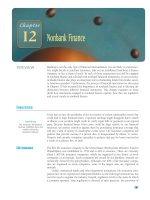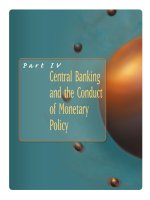Money banking and the financial system 1e by hubbard and OBrien chapter 02
Bạn đang xem bản rút gọn của tài liệu. Xem và tải ngay bản đầy đủ của tài liệu tại đây (493.69 KB, 40 trang )
R. GLENN
HUBBARD
ANTHONY PATRICK
O’BRIEN
Money,
Banking, and
the Financial
System
© 2012 Pearson Education, Inc. Publishing as Prentice Hall
CHAPTER
2
Money and the Payments System
LEARNING OBJECTIVES
After studying this chapter, you should be able to:
2.1
Analyze the inefficiencies of a barter system
2.2
Discuss the four key functions of money
2.3
Explain the role of the payments system
2.4
Explain how the U.S. money supply is measured
2.5
Use the quantity theory of money to analyze the
relationship between money and prices in the long run
© 2012 Pearson Education, Inc. Publishing as Prentice Hall
CHAPTER
2
Money and the Payments System
THE FEDERAL RESERVE FIGHTS TO PRESERVE ITS INDEPENDENCE
•Facing criticism from Congress about the Fed’s actions during the crisis, Fed
Chairman Ben Bernanke insisted on the need for the Fed to remain
independent from the rest of the federal government.
•An example of a country without central bank independence is Zimbabwe,
where the inflation rate during 2008 was an almost unimaginable 15 billion
percent!
•Most economists believe that there is a connection between how independent
a country’s central bank is and how much inflation the country experiences.
•An Inside Look at Policy on page 44 discusses the Fed’s new role as the key
regulator of the financial sector.
© 2012 Pearson Education, Inc. Publishing as Prentice Hall
Key Issue and Question
Issue: The Federal Reserve’s actions during the financial crisis led to
concerns about whether it could maintain its independence.
Question: Should a central bank be independent of the rest of the
government?
© 2012 Pearson Education, Inc. Publishing as Prentice Hall
Learning
2.1
Objective
Analyze the inefficiencies of a barter system.
© 2012 Pearson Education, Inc. Publishing as Prentice Hall
5 of 40
Economists define money very broadly as anything that is generally accepted
as payment for goods and services or in the settlement of debts.
Do We Need Money?
© 2012 Pearson Education, Inc. Publishing as Prentice Hall
6 of 40
Barter
Economies can function without money.
Barter A system of exchange in which individuals trade goods and services
directly for other goods and services.
Do We Need Money?
© 2012 Pearson Education, Inc. Publishing as Prentice Hall
7 of 40
Barter
There are four main sources of inefficiency in a barter economy:
1. There must be a double coincidence of wants. The time and effort spent
searching for trading partners in a barter economy increases the transactions
costs.
Transactions costs The costs in time or other resources that parties incur
in the process of agreeing and carrying out an exchange of goods and
services.
2. Each good has many prices.
When there are N items: Number of prices = N(N – 1)/2.
3. There is a lack of standardization.
4. It is difficult to accumulate wealth.
Do We Need Money?
© 2012 Pearson Education, Inc. Publishing as Prentice Hall
8 of 40
The Invention of Money
In growing an economy, there is an incentive to identify a specific product
that most people will generally accept in an exchange.
A good used as money that also has value independent of its use as
money is called commodity money.
Making the Connection
What’s Money? Ask a Taxi Driver!
• During a visit to Russia in 1989, one of the authors of this book
navigated with difficulty through the streets of Moscow because Russian
merchants and taxi drivers discouraged payments in rubles.
• Taxi drivers quoted fares in dollars, marks, and yen.
• For taxi drivers, Marlboro cigarettes were the commodity money of
choice.
Do We Need Money?
© 2012 Pearson Education, Inc. Publishing as Prentice Hall
9 of 40
The Invention of Money
Specialization A system in which individuals produce the goods or services for
which they have relatively the best ability.
Once money is invented, people can specialize, become far more productive,
and earn higher incomes.
Do We Need Money?
© 2012 Pearson Education, Inc. Publishing as Prentice Hall
10 of 40
Learning
2.2
Objective
Discuss the four key functions of money.
© 2012 Pearson Education, Inc. Publishing as Prentice Hall
11 of 40
Money serves four key functions in the
economy:
1.It acts as a medium of exchange.
2.It is a unit of account.
3.It is a store of value.
4. It offers a standard of deferred payment.
Medium of Exchange
Medium of exchange Something that is generally accepted as payment for
goods and services; a function of money.
Unit of Account
Unit of account A way of measuring value in an economy in terms of money; a
function of money.
The Key Functions of Money
© 2012 Pearson Education, Inc. Publishing as Prentice Hall
12 of 40
Store of Value
Store of value The accumulation of wealth by holding dollars or other assets
that can be used to buy goods and services in the future; a function of money.
• While you incur transactions costs when you exchange other
assets for money, money is, of course, perfectly liquid. People hold
money to avoid transactions costs, even though other assets offer a greater
return as a store of value.
Standard of Deferred Payment
Money can facilitate exchange not only at a point in time, but also
over time, as a standard of deferred payment.
The Key Functions of Money
© 2012 Pearson Education, Inc. Publishing as Prentice Hall
13 of 40
Distinguishing Among Money, Income, and Wealth
• Money, like other assets, is a component of wealth, which is the
sum of the value of a person’s assets minus the value of the
person’s liabilities.
• However, only if an asset serves as a medium of exchange can we
call it money.
• A person’s income is equal to his or her earnings over a period of
time.
• So, a person typically has considerably less money than income or
wealth.
The Key Functions of Money
© 2012 Pearson Education, Inc. Publishing as Prentice Hall
14 of 40
What Can Serve as Money?
An asset is suitable to use as a medium of exchange if it is:
•Acceptable to (that is, usable by) most people.
•Standardized in terms of quality, so that any two units are identical.
•Durable, so that it does not quickly become too worn out to be usable.
•Valuable relative to its weight, so that amounts large enough to be useful in
trade can be easily transported.
•Divisible, because prices of goods and services vary.
U.S. paper currency—Federal Reserve Notes—meet all these criteria.
The Key Functions of Money
© 2012 Pearson Education, Inc. Publishing as Prentice Hall
15 of 40
The Mystery of Fiat Money
Fiat money Money, such as paper currency, that has no value apart
from its use as money.
The federal government has designated paper currency to be legal
tender, which means the government accepts paper currency in
payment of taxes and requires that individuals and firms accept it in
payment of debts.
Our society’s willingness to use green pieces of paper issued as
money makes them an acceptable medium of exchange.
The Key Functions of Money
© 2012 Pearson Education, Inc. Publishing as Prentice Hall
16 of 40
Making the Connection
Apple Didn’t Want My Cash!
• To prevent the resale of new iPads, any customer wanting to buy an
iPad had to pay either with a credit card or a debit card. This would
make it easier for Apple to keep track of anyone attempting to buy more
than the limit of two per customer.
• Firms do not have to accept cash as payment for goods and services.
For example, a bus line may prohibit payment of fares in pennies or
dollar bills.
• The woman who tried to buy an iPad for cash was disabled, and the
case drew bad publicity, so Apple gave her a free iPad and rescinded
ban on paying for iPads with cash.
The Key Functions of Money
© 2012 Pearson Education, Inc. Publishing as Prentice Hall
17 of 40
Learning
2.3
Objective
Explain the role of the payments system.
© 2012 Pearson Education, Inc. Publishing as Prentice Hall
18 of 40
Payments system The mechanism for conducting transactions in the
economy.
The Transition from Commodity Money to Fiat Money
• An economy’s reliance on gold and silver coins alone makes for a
cumbersome payments system.
• To get around this problem, early banks began to store gold coins in safe
places and issue paper certificates. In effect, paper currency had been
invented.
• In modern economies, the central bank issues paper currency but does not
exchange it for gold or any other commodity money.
The Payments System
© 2012 Pearson Education, Inc. Publishing as Prentice Hall
19 of 40
The Importance of Checks
• Checks are promises to pay on demand money deposited with a bank or
other financial institution.
• The use of checks avoids the drawbacks of paper money, but also requires
more trust on the part of the seller.
The Payments System
© 2012 Pearson Education, Inc. Publishing as Prentice Hall
20 of 40
Electronic Funds and Electronic Cash
• Electronic funds transfer systems have greatly improved the efficiency in
settling and clearing transactions. Here is how:
• Cash registers are linked to bank computers, so when a customer uses a
debit card, his bank instantly credits the store’s account. In this way, debit
cards eliminate the problem of trust.
• ACH transactions include direct deposits of payroll checks and electronic
transfers, which help to reduce transactions costs, the likelihood of missed
payments, and the costs of notifying borrowers of missed payments.
• ATMs add the convenience of withdrawing funds from your bank anytime,
away from your bank.
• E-money, or electronic money, is digital cash people use to buy goods and
services over the Internet.
The Payments System
© 2012 Pearson Education, Inc. Publishing as Prentice Hall
21 of 40
Learning
2.4
Objective
Explain how the U.S. money supply is measured.
© 2012 Pearson Education, Inc. Publishing as Prentice Hall
22 of 40
Measuring Monetary Aggregates
Monetary aggregates Measures of the quantity of money that are
broader than currency; M1 and M2.
M1 A narrower definition of the money supply: The sum of currency in
circulation, checking account deposits, and holdings of traveler’s
checks.
M2 A broader definition of the money supply: all the assets that are
included in M1, as well as time deposits with a value of less than
$100,000, savings accounts, money market deposit accounts, and
noninstitutional money market mutual fund shares.
Measuring the Money Supply
© 2012 Pearson Education, Inc. Publishing as Prentice Hall
23 of 40
Figure 2.1
Measuring the Money Supply, July 2010
Measuring the Money Supply
© 2012 Pearson Education, Inc. Publishing as Prentice Hall
24 of 40
Making the Connection
Show Me the Money!
• As more U.S. currency is held outside the United States, the ratio of
currency to checking deposits increases.
• As much as two-thirds of the $886.5 billion in currency outstanding in July
2010 was held outside the United States. People in other countries see the
dollar as a safe haven when their own currencies are unstable.
Measuring the Money Supply
© 2012 Pearson Education, Inc. Publishing as Prentice Hall
25 of 40









